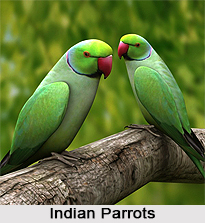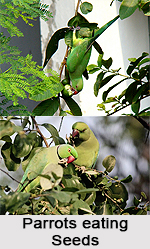 Indian Parrot, also known as the "Ring-Necked Parakeet", is a gregarious tropical Afro-Asian parakeet species that has an extremely large range. The Indian Parrot originates from southern India. Indian Parrots natively reside in Asia - mainly India and Pakistan. They are forest dwelling animals that will occasionally forage for food on the ground. The parrots are a broad order of more than 350 birds. Macaws, Amazons, lorikeets, lovebirds, cockatoos and many others are all considered parrots. Parrots are found in warm climates all over most of the world. As a popular pet species, escaped birds have colonized a number of cities around the world.
Indian Parrot, also known as the "Ring-Necked Parakeet", is a gregarious tropical Afro-Asian parakeet species that has an extremely large range. The Indian Parrot originates from southern India. Indian Parrots natively reside in Asia - mainly India and Pakistan. They are forest dwelling animals that will occasionally forage for food on the ground. The parrots are a broad order of more than 350 birds. Macaws, Amazons, lorikeets, lovebirds, cockatoos and many others are all considered parrots. Parrots are found in warm climates all over most of the world. As a popular pet species, escaped birds have colonized a number of cities around the world.
Physical Features of Parrot
Characteristic features of parrots include a strong, curved bill, an upright stance, strong legs and clawed zygodactyl feet. The Indian Parrot is sexually dimorphic. The adult male sports a red or black neck ring and the hen and immature birds of both sexes either show no neck rings, or display shadow-like pale to dark grey neck rings. Both sexes have a distinctive green colour. Indian Parrots measure on average 40 cm in length, including the tail feathers, a large portion of their total length. It is herbivorous and not migratory.
Habitat of Parrot
They originally lived in semi-desert, wooded or forested areas; but have also adapted well to human-modified habitats, such as farmlands, cultivated agricultural areas and parks and gardens in villages and towns. The social Indian Parrots often congregate in large, noisy flocks at favorite roosting sites. Like all parrots, they are noisiest in the mornings and evenings.
Diet of Parrot
The most important components of most parrots` diets are seeds, nuts, fruit, buds and other plant material. A few species sometimes eat animals and some small creatures such as insects, while the lories and lorikeets are specialized for feeding on floral nectar and soft fruits.
Breeding of Parrot
Within their natural range, Indian Parrots mostly breed between February and March, although some breeding activities have been observed in April. Indian Parrots reach reproductive maturity when they are about 1 to 1 and 1/2 years old. However, they may not breed until they are 2 to 4 years old. Females may successfully start breeding as early as 1 year and males at 2 years. The pair bonds of the parrots and cockatoos are strong and a pair remains close even during the non-breeding season, even if they join larger flocks. Almost all parrots nest in tree hollows and lay white eggs.
 Characteristic Features of Parrot
Characteristic Features of Parrot
Many parrots are kept as pets, especially Macaws, Amazon Parrots, Cockatiels, Parakeets and Cockatoos. These birds have been popular companions throughout history because they are intelligent, charismatic, colorful, and musical. Some birds can imitate many non-avian sounds, including human speech.
Conservation of Parrot
Some parrot species are highly endangered. Of the 350 or so living species, 130 are listed as near threatened and 16 are currently considered critically endangered. There are several reasons for the decline of so many species. Parrots are persecuted because, in some areas, they are hunted for food and feathers, and as agricultural pests. Trapping wild parrots for the pet trade, as well as hunting has diminished wild populations, with parrots being subjected to more exploitation than any other group of birds. There are many active conservation groups whose goal is the conservation of wild parrot populations. One of the largest is the World Parrot Trust, an international organization. Zoo and wildlife centers usually provide public education, to change habits that cause damage to wild populations.



















